By JULIE MINDA
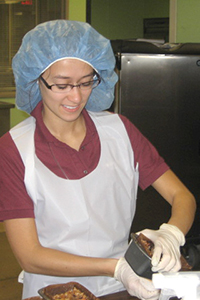
A volunteer prepares a fruitcake for CHI Health Midlands' annual fundraiser. A cake placed in the hospital's "time trunk" was intact when the trunk was opened 40 years later.
Historical documents, black-and-white photographs, and the front page of a local newspaper are all items that one might expect to find when unpacking a long-sealed time capsule.
But, a fruitcake?
That is the first item a CHI Health Midlands executive pulled from a decades-old "time trunk" last year during a 40th anniversary celebration for the Papillion, Neb., hospital. According to Tamara Field, the hospital's interim vice president of patient care services, hospital volunteers have sold fruitcakes as an annual Christmas fundraiser since the hospital's 1976 founding. One of the cakes was placed in the time trunk shortly after the hospital began operations.
The cake stored in the capsule was still intact last year, says Field, although nobody dared to bite into a slice — it was brick hard. "It's amazing to know how long the fruitcake survived, and that is a metaphor for the hospital. There have been times when we didn't know if we would have to close our doors" due to periodic, pronounced financial struggles. "But we've survived," she says.
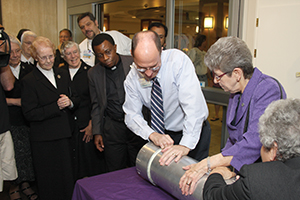
During a May 2012 ceremony, CHRISTUS Southeast Texas St. Elizabeth leaders open a time capsule that had been sealed 25 years prior. James Pearson, facilities director, gets a steadying hand from Sr. Celeste Trahan, CCVI, to his right. She is a member of one of CHRISTUS Health's sponsoring congregations, the Sisters of Charity of the Incarnate Word.
The facility is among the many institutions that have sought to capture and preserve bits of the contemporary experience of health care providers, so it can be viewed afresh by the generations that follow. Given Catholic hospitals' grounding in the church's healing ministry, time capsules often include cherished artifacts and documents that demonstrate ways they have lived out their mission over time, says Peggy Van Gundy, system director of mission and formation for St. Louis-based SSM Health. Several of that system's facilities have time capsules.
Community ties
Like many ministry hospitals, two SSM Health campuses that created time capsules in recent years involved their associates and community members in choosing, and creating, items for inclusion.
Scott Grimwood, SSM Health system manager of archives, said the capsule placed in January 2013 at the replacement hospital for SSM Health Good Samaritan Hospital–Mt. Vernon, Ill., contains memorabilia celebrating the new hospital — site plans, a commemorative booklet, a time lapse video of construction — along with community photos and rosters of community members whose donations helped fund the new facility.

This guestbook is in a time capsule buried on the campus of Dell Seton Medical Center. The hospital opens next month.
Good Samaritan's time capsule and that of SSM Health St. Mary's Hospital — Janesville, Wis., both include artwork by the winner of children's art contests connected with the openings of the respective hospitals. Grimwood said it was important to administrators to engage community members in the time capsule creation. St. Mary's sealed and stored its capsule in December 2011.
Forecasting
Filling a time capsule likewise was a community affair at Dell Seton Medical Center at The University of Texas in Austin, an Ascension teaching hospital that is to replace Ascension's University Medical Center Brackenridge next month.
A year ago, the medical center invited staff, physicians and members of the public to submit prognostications about health care in the future, to be considered for inclusion in the new hospital's time capsule, which is to be opened in 25 or 50 years. A panel of medical center clinicians, faculty and other experts evaluated the submissions and chose the best for inclusion.
Carl McQueary, mission integration coordinator for Ascension's Texas ministry market, says the chosen predictions "read like the Jetsons." (The 1960s cartoon set 100 years in the future predicted the advent of talking alarm clocks, video phones, flat screen TVs and robotic vacuum cleaners.)
One prognostication included in the Dell Seton time capsule foresees that patients will have microchip implants containing all of their medical history. Another anticipates that an individual's DNA will routinely be used to inform the optimum patient-specific treatment. Another predicts that much hospital-level care will be home based and facilitated by advances in technology and telemedicine, and hospital campuses will be repurposed as medical malls that cluster outpatient services.
Along with the predictions, the time capsule buried on the Dell Seton campus contains a guestbook with hand-written greetings from hundreds of staff, clinicians and community members; a letter from the head of Ascension's Texas ministry market; a statement about that market's strategic direction and photos of Daughters of Charity. In 1902, that congregation founded what became Ascension's health ministry in Austin.
"We wanted to say: here's where we are, here's where we came from, and here's where we are heading," McQueary, who headed the time capsule project, says.
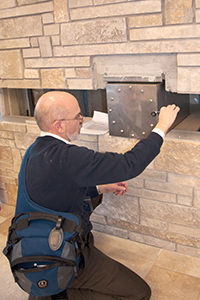
Scott Grimwood, SSM Health system manager of archives, seals a time capsule in a wall at SSM Health Good Samaritan Hospital – Mt. Vernon in 2013.
Evolution
For many facilities, time capsule contents put in sharp relief the changes the facility is undergoing.
CHI Health is constructing CHI Health Creighton University Medical Center Bergan Mercy on the campus of the CHI Health Bergan Mercy hospital in Omaha, Neb. A committee is looking into what it might put into a new time capsule. They're considering putting in flash drives with information about the hospital as well as newspaper articles, book excerpts on Bergan and a recording of a dramatic monologue on the Sisters of Mercy, according to Debra Skinner, CHI Health Foundation development officer for Bergan. "It's painting a picture of who we are today," in the lead-up to a significant campus change, she says.
The new capsule will be placed alongside a capsule with 50-year-old contents that was retrieved from its berth in a cornerstone in a hospital building in 2014. Its contents include a rosary, newspapers and statues of saints.
John Winkelman is community relations manager at Mercy Hospital Jefferson in Festus, Mo., part of Mercy health system of Chesterfield, Mo. The campus is undergoing a major renovation. The hospital plans to place a 2007 time capsule and its stone marker disrupted by the construction, in a courtyard frequented by co-workers. Created to mark the hospital's 50th anniversary, it will be opened again when the hospital turns 100.
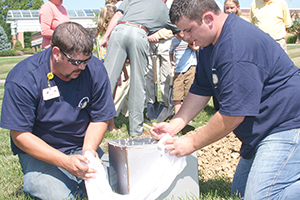
Facilities management staff of Mercy Hospital Jefferson put the final seal on a time capsule before lowering it into the ground in 2007. Current renovations required the removal of the capsule and Mercy Hospital will rebury it with its stone marker in a courtyard frequented by staff.
"The importance of the time capsule is reflected in how rapidly our history has changed even in just the past 10 years, and how it may change in the coming decades," Winkelman says. "When it was buried in 2007, we were … an independent community hospital. In 2008 we rebranded … to reflect our growing scope of services and market presence. In 2013, we became a part of the Mercy ministry."
He said joining the Catholic health ministry "has brought tremendous growth to our facilities, strength to our ability to serve and a renewed commitment to the best health care in our community."
Old and new
For its 50th anniversary in 2012, CHRISTUS Southeast Texas St. Elizabeth in Beaumont, Texas, unsealed a capsule packed at its 25th anniversary and resealed it with all new items for a future unveiling. Among the artifacts inserted in 1987 were a history video, the Bible of the sister heading the hospital at the time and local periodicals. Those items were replaced with artifacts suggested by associates, including a 50th anniversary banner signed by associates.
At CHRISTUS St. Michael Health System in Texarkana, Texas, a committee is assembling a time capsule in connection with the system's 100th anniversary. They are planning to include, among other items, 100-year celebration memorabilia, a cell phone, organizational charts and a stethoscope. They also plan to pack a printout of medical coding books. Future generations "will probably look at them and laugh," says Francine Francis, marketing and communications director at CHRISTUS St. Michael.
Nancy Cook, regional director of spiritual care for CHRISTUS Southeast Texas, says while it's fun to assemble such capsules, they actually have a very profound purpose, of connecting different generations to the same healing ministry.
Digging up the past can bring unforeseen challenges, surprises
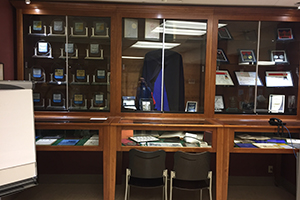
Among the items showcased in these display cases at Mercy Hospital of Buffalo, N.Y., are artifacts recovered from time capsules that had been sealed in cornerstones at the hospital. The capsules were extracted during campus renovations and opened.

During a 2013 celebration, members of Mercy Hospital's founding congregation, the Sisters of Mercy, bless a new monument. The monument was created using the faceplates of cornerstones from 1926 and 1967, as well as a 2010 faceplate created at the start of an emergency department renovation.
Finding a rumored time capsule at CHI Health Bergan Mercy hospital in Omaha, Neb., was "like a treasure hunt," says Jim Quinn, the facility's operations director.
In the lead-up to the hospital's 50th anniversary in 2014, an administrator had tasked Quinn with finding a capsule that was thought to be sealed somewhere in the original hospital building, which had been expanded over the years. Quinn says he explored the campus looking for the capsule location and talked with some long-timers to learn whether they'd heard anything about a capsule — all to no avail. But he eventually talked to an associate who recalled reading about a time capsule on a historical timeline wall at the hospital.
Quinn scanned the heritage wall and saw the reference to a ceremony in which a bishop prepared a time capsule for placement in a hospital cornerstone. Quinn recognized, in an accompanying historical photo on the wall, the cornerstone location. In 2014, it was a little-used patio area. Sure enough, when he walked to the patio, he found the cornerstone he'd seen in the photo.
Quinn reviewed faded, hand-drawn blueprints from 1963. "We needed to know the approximate depth of the (cornerstone) and the impact that removing the stone could possibly have to an existing physical therapy space as well as the impact it could have to the building structure."
A restoration contractor who'd done work at the hospital donated his time to excavate the stone in order to extract the capsule. Quinn says the cavity was backfilled temporarily with insulation and plywood until it was permanently filled with concrete.
Quinn says he "felt like Indiana Jones" opening the capsule. It contained period photos, coins, newspapers, a booklet about the hospital, statues of saints of importance to the hospital's founding sponsors, personnel policies of the hospital, bonds for the facility's construction and other memorabilia. The hospital displayed the items at an anniversary celebration in 2014. The capsule has since been resealed and will be placed next to a new capsule to be installed on campus after a significant renovation is complete.
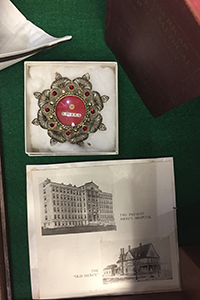
These items had been sealed in the time capsules and were found when the capsules were opened.
Sometimes capsules are lost irretrievably. Carl McQueary is mission integration coordinator for Ascension's Texas ministry market, and he heads a committee that filled a time capsule last year for an Ascension teaching hospital campus soon to open in Austin, Texas.
McQueary says that in 1976 officials at Seton Medical Center — now part of Ascension — opened a time capsule that had been buried at the hospital's predecessor, Seton Infirmary. At some point after the capsule's unveiling 40-plus years ago, the capsule and its contents disappeared. "It's a great mystery — it still has not been found," he says.
Sometimes facilities' institutional memory fails over generations and capsules are forgotten. That was the case at Mercy Hospital of Buffalo, N.Y., according to C.J. Urlaub, president and chief executive of the facility.
A 2010 project to expand Mercy Hospital's emergency department disrupted the hospital's original 1926 cornerstone and a cornerstone erected during a 1967 hospital addition. Urlaub says hospital leaders knew about a time capsule behind the 1967 cornerstone, but they were surprised when the 1926 cornerstone was removed from the building to find that it, too, contained a capsule.
The contents of both capsules are on display in a viewing case at Mercy. The artifacts include newspaper articles, relics of saints and a pope, nursing memorabilia and historical photographs.
Mercy created a monument, which stands 10 feet tall and looks like an arched doorway, to house a time capsule it sealed in 2013, and the respective faceplates of the cornerstones set in 1926 and 1967. The monument stands in a Mercy meditation garden.
The 2013 capsule, assembled by a committee of hospital staff and sisters from the hospital's founding congregation, the Sisters of Mercy, is to be opened in 2063. It contains full rosters of the hospital's associates, physicians and volunteers; photos of the hospital at various times in its history; documents explaining the hospital's conversion to an electronic medical record system and cell phones and flash drives to represent electronics in use in 2013.
— JULIE MINDA